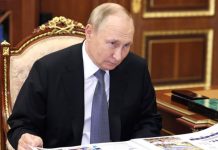
June 27 (UPI) — Defense ministers from NATO member countries are considering increasing military exercises and boosting intelligence as a response if Russia declines to destroy ground-launched missiles that violate a treaty with the United States, NATO Secretary-General Jens Stoltenberg said Wednesday.
Stoltenberg issued the threat Tuesday, telling Russia it must eliminate and stop development of the SSC-8, which is known as the 9M729 in Russia. It’s a short- and intermediate-range missile that the United States and NATO says breaks the 1987 Intermediate-Range Nuclear Forces Treaty between Russia and United States.
Defense officials met in Brussels to discuss possible repercussions should Russia miss the five-week deadline to destroy the weapons.
“Ministers have agreed that NATO will respond should Russia fail to return to compliance,” Stoltenberg said. “They will have to bear the full responsibility for the demise of the treaty.”
Included in the possible response is an increase in military exercises, intelligence, surveillance and reconnaissance, and a boost to air and missile defenses and conventional weapons.
“Ministers confirmed today that we have no intention to deploy new land-based nuclear missiles in Europe. We will not mirror what Russia does. We do not want a new arms race,” Stoltenberg added.
Also Wednesday, Russian Deputy Foreign Minister Sergei Ryabkov said Russia will be forced to take retaliatory measures if NATO follows through on its threat.
“Attempts to portray what is happening as a military and political response to Russia’s actions reek of a propaganda campaign with a large element of deliberate misinformation being fed to global public opinion,” he said. “When these threats begin to materialize into real action, we will have to take countervailing military measures.
The missiles and their mobile launch systems have a range of 310 miles to 3,417 miles, the Center for Strategic and International Studies Missile Defense Project says, which violates the 1987 Intermediate-Range Nuclear Forces treaty between Russia and United States. The agreement banned the two countries from having land-based ballistic and cruise missiles with ranges between 310 miles and 3,417 miles.
Russian military officials deny the SSC-8 missile’s range violates the treaty.
In February, U.S. Secretary of State Mike Pompeo said the United States planned to abandon the treaty because of Russia’s violations in developing the SSC-8 dating back to 2014. Russia announced its plans to withdraw the next day, accusing the United States of violating the treaty since 1999 by testing combat unmanned aerial vehicles. Russia said such vehicles have similar characteristics as land-based cruise missiles.
It requires six months to withdraw from the treaty, which means it’s still in place through early August.
Days after the withdrawal announcements, Russian Defense Minister Sergei Shoigu said Moscow planned to develop new ground-based nuclear missiles by the end of 2020.
Stoltenberg said violations of the INF Treaty could pose a risk to security in Europe because they are difficult to detect and have a shorter warning time than long-range missiles. He said NATO believes the United States is in full compliance with the agreement.
“There are no new U.S. missiles in Europe, but there are new Russian missiles in Europe,” he said in December.





